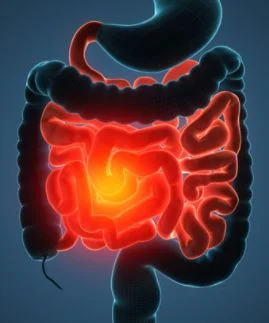Crohn’s disease can be both debilitating and extremely painful, while having life-long effects on those who contract it. It is poorly understood, at least partially because the cause is unknown. Conventional treatments have managed only to relieve the symptoms for a time, without being able to provide a permanent cure. Many patients will undergo surgery, sometimes multiple times, to try and prevent the condition from worsening.
Recently, advances in stem cell technologies have led to new and exciting treatment methods for Crohn’s disease that aim to repair the damage and make steps towards finding a cure. Recent research has also shown that stem cell therapy is safe for patients with Crohn’s disease. But first, let’s dive get a basic understanding of Crohn’s disease, so we can understand how stem cells can make a difference.
What is Crohn’s Disease?
Crohn’s disease is a complex condition that causes inflammation within the digestive system. Depending on which parts of the system are affected, patients may experience a range of symptoms. Once food has been broken down by the action of the stomach, it then passes through the small intestine and into the large intestine. The small intestine is where the majority of the nutrients of the food are absorbed into the body, while the large intestine reabsorbs water and further breaks down the remaining residue to be excreted from the body.
Crohn’s disease mostly causes inflammation to occur at the latter part of the small intestine, where smaller nutrients are absorbed, and in the large intestine. This can cause problems with nutrition, but mainly patients experience diarrhea, fever, fatigue, and severe pain or cramping in the abdomen.
Most patients experience the condition intermittently with symptoms developing and lasting for lengths of time that are then interspersed with periods of intermission without experiencing many symptoms at all. Symptoms might flare up during intermission due to stress, certain types of food, or many other triggers that vary from individual to individual.
Despite much research in the field, it is not yet known what causes the disease. It has been observed that it is more common in those with a family history of the disease, but it can also occur in those who are not related to any known sufferers. Scientists therefore suspect that though genetics may play a role in determining susceptibility to the disease, it is not the only factor. It is also unknown what exactly causes the inflammation, although many suspect the body’s own immune system plays a role by attacking parts of the body in response to some trigger.
As of right now there is no known cure for Crohn’s disease. Sufferers will usually continue to experience the condition for their entire lives. Moreover, the conventional therapies and treatments that do exist only relieve the symptoms without fully eliminating them.
Conventional Therapies for Crohn’s Disease
The treatments of Crohn’s disease are many and varied. Since patients have so many different kinds of symptoms that are experienced to different extents, it has so far been impossible to determine a course of treatment that is successful in all cases. Instead, patients must undergo a range of different treatments in the hopes of finding one that will be successful in reducing the negative effects of the disease. Ultimately, half of all patients will eventually undergo surgery to temporarily relieve the symptoms and then hope that the disease does not recur.
Anti-Inflammatory Drugs
To reduce the levels of inflammation within the digestive tract, many patients are prescribed anti-inflammatory drugs. These do not directly address the causes of the disease but instead reduce the levels of damaging or disruptive symptoms and provide some level of relief to the patient.
Immune System Suppressors
Either alone or as part of a cocktail of medicines, those who suffer from Crohn’s disease may take a number of different immune suppressors to reduce the function of their immune system. Since it is the immune system that causes inflammation in patients with Crohn’s disease, these drugs will lead to a reduction in inflammation.
Patients will often have to try a number of different drugs before finding one that works to improve their condition, without also causing significant side effects. The reduction in the function of the immune system is a major side-effect caused by these drugs and makes the patient more susceptible to other diseases.
Dietary Change
While it hasn’t been established that diet can be a cause of Crohn’s disease, it can certainly exacerbate symptoms, especially during a flare-up. This is another aspect of Crohn’s disease that depends a lot on the individual. To identify individual needs and sensitivities, it is often suggested that sufferers keep a food journal to keep track of what they are eating as well as when they experience symptoms. This allows the individual to track their flare-ups over time and look for foods that might exacerbate their symptoms.
Surgery
As mentioned before, about half of all of those who suffer from Crohn’s disease will end up having surgery to provide relief when their symptoms become too great. This usually consists of removing the parts of the intestine that have become most severely damaged, and then joining the relatively healthy ends that remain.
Surgery can also be used to repair some forms of major damage to the intestine. Sometimes the lining of the intestine becomes damaged in such a way that an abscess can form. In rare cases these abscesses may become so deep that they create a hole in the wall of the intestine, and eventually create a fistula (or tunnel) between the intestine and another part of the body. This is clearly very dangerous since it can cause undigested materials to spread throughout the body. Fortunately, both of these kinds of issues can be repaired by surgery.
Despite all of these treatments, most sufferers of Crohn’s disease won’t ever be cured. Current practices involving traditional therapies aim to treat and manage a patient’s symptoms, without being able to permanently repair the damage to the intestine. Fortunately, advances in stem cell technology are providing new pathways towards finding a cure.
How Does Stem Cell Therapy Treat Crohn’s Disease?
While we don’t know the cause of the damage to the intestine in Crohn’s patients, we do know what kind of damage is done and how it causes the symptoms that patients experience. Current specialists believe that the damage to the mucosal layer of the intestine – the layer that comes directly into contact with the digested food – is the biggest cause of Crohn’s symptoms. Healing this damage is therefore seen as the best way to try and provide a cure.
New treatments for Crohn’s disease aim to reduce the inflammation in the intestine to prevent further damage, while at the same time repairing the damaged tissues to the furthest possible extent. In a wide range of studies, stem cells have been shown to have restorative properties to the body’s tissues. This happens through a combination of the cells being able to differentiate into the same type as the cells in the damaged tissues and replace those that need replacing, and the production of growth factors that promote growth and healing of damaged cells. These properties of stem cells have been shown to provide anti-inflammatory effects throughout various parts of the body. This has led to hope in recent years for the use of stem cells when it comes to treating Crohn’s disease.
Different types of stem cells have been used for different purposes. These included both hematopoietic cells and mesenchymal cells. Hematopoietic cells include just those that can eventually become different types of blood cells, while mesenchymal cells refer to those that can become a much broader range of cells.
When it comes to treatments for Crohn’s disease, a few differences between these types of cells have been observed, as documented in a recent paper that sums up the current state of research. In a number of studies, both types have seen to have positive effects for treating the damage caused by Crohn’s disease, even being more successful than traditional treatments in some cases. However, several studies also showed that hematopoietic stem cell treatments might also cause adverse side effects not seen with traditional treatments. For that reason, using these types of cells is not recommended as an improvement over the traditional methods.
Conversely, treatments that used mesenchymal stem cells were both successful and showed no signs of severe side effects, making them an improvement on traditional therapies.
When it comes to Crohn’s disease, current research is being done to investigate the potential use of stem cells in the most severe cases, where improvement would be most noticeable. Such cases can usually be identified through the presence of severe abscesses or fistula. Many of the clinical trials referred to in this paper looked at uses of stem cells in improving the treatment of these abscesses and fistulae.
These studies are easier to conduct since this kind of damage is easy to measure, and trials looking to first prove the effectiveness of a particular method of treatment usually focus on particularly severe cases. Now that this effectiveness has been demonstrated, trials are beginning to be conducted that aim to use stem cells to treat the less physically obvious symptoms of Crohn’s disease.
Since the damage to the intestine first begins at the mucosal layer, it would be a huge breakthrough to be able to repair damage that occurs here. Studies are currently underway to determine how stem cells can be used to carry out mucosal healing. Rather than using hematopoietic cells that can be dangerous, or mesenchymal cells that can be effective in some situations, these new studies are using stem cells that come from the lining of the intestines themselves.
Since these stem cells come from the same part of the body as where the damage is being done, it is expected that the repairs that they will carry out will be more significant than those carried out by cells from other parts of the body. Stem cell therapy is a safe and effective treatment for patients with Crohn’s disease.
Stem Cell Therapy was Found to be Safe for Crohn’s Disease
One such study was conducted in 2019 that was designed to investigate the success of treating patients suffering from perianal fistula – passages linking the large intestine to the body’s surface near the rectum – with stem cells. The study used stem cells obtained from the bone marrow of donors and injected them into patients. The study looked at several different concentrations of injections as well as a control group to investigate the safety and success of different strengths of treatments. Since Crohn’s disease is a chronic condition, the patients were tracked for 4 years to investigate the degree to which the treatment would have lasting positive effects, without producing negative side-effects that might go unnoticed in the short term.
The researchers concluded that not only was the therapy safe, but it was also an effective treatment. When patients were followed up with after 24 weeks and then again at 4 years, the majority of them were found to have had their fistulae close up entirely, with many of the others experiencing at least partial closure. Other measurements of the degree to which Crohn’s disease was affecting their daily life also showed improvement over time.
These results provide excellent news to current patients with Crohn’s disease. Since it is a degenerative disease, with traditional treatments providing only minor or temporary relief, the existence of a possible treatment that is safe and can reverse the effects of the disease is a huge step forward. Of course, the nature of the treatment as a one-time injection of stem cells in place of a surgery that would likely need to be repeated is also a huge advantage.
These advances in regenerative science for the treatment of the damage done by Crohn’s disease are extremely promising. Having been able to identify and create treatments that are both safe and effective means that these techniques can be further refined as the field develops. Here, more than almost anywhere else in medicine, research is advancing at an extraordinary rate and stem cell treatments continue to improve alongside the research.


